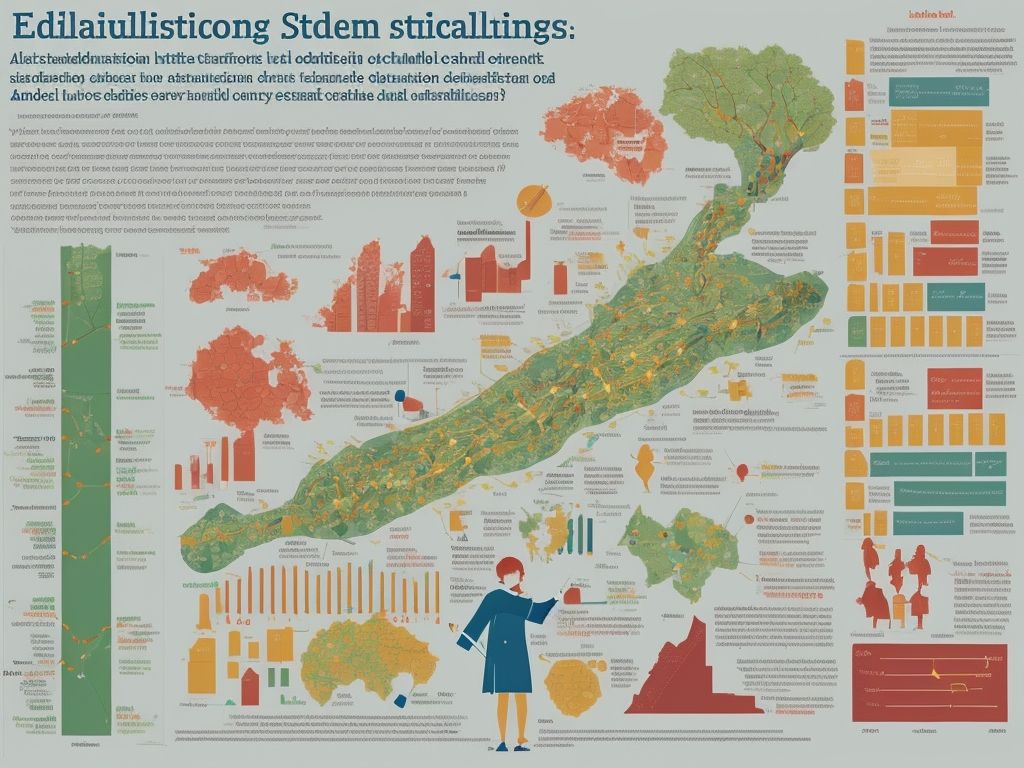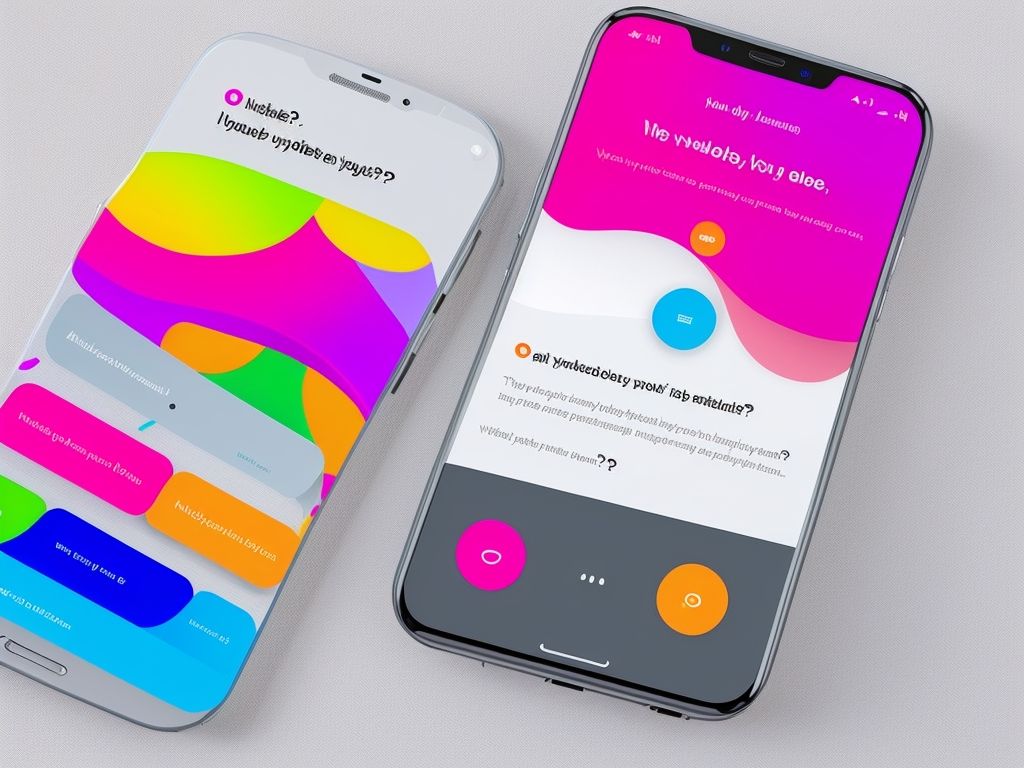Evaluating Student Perception Surveys
Student perceptions are essential for judging an educational system’s effectiveness. Knowing what the students think gives us helpful information on school practices and what needs to be improved. This article highlights the importance of student perception surveys in understanding student experiences in diverse academic settings.
Student perception surveys have become popular. They offer a chance for students to share their opinions on teaching styles, course design, classrooms, and support services. Educators can use this feedback to make better decisions and improve the learning experience for all.
By analyzing student perception surveys, schools can spot trends. For instance, if many students are unhappy with a teaching method, this suggests that instructional improvement is needed. Surveys are also useful for recognizing factors that influence student engagement and for creating an atmosphere that helps students to be successful.
Johnson et al. (2018) found that student feedback gathered through surveys led to changes in teaching and course design at university level. This shows the real value of these surveys in providing positive changes within educational institutions.
Background of Student Perception Surveys
Student Perception Surveys have become popular. They give a unique view of students’ experiences. These surveys are usually done in academic institutions. They help to measure student satisfaction, find areas for improvement, and make the learning environment better. Through them, students can share their opinions and positively affect their educational journey.
Educators and administrators benefit from these surveys. By looking at the feedback, schools can get a better understanding of their teaching methods, curriculum design, and support services. This lets them make decisions and make changes to make the learning environment better.
An amazing aspect of student perception surveys is that they promote student engagement and let students shape their education. When students know their opinions are valued, they feel respected. This motivates them to take charge of their learning and work hard.
Educators and students should recognize the importance of student perception surveys. Educators can use the feedback to modify instruction, improve communication, and create personalized learning experiences. Students can use them to share concerns or suggestions about classroom dynamics, assessment methods, and other aspects of their academic journey.
For student perception surveys to be effective, students need to give honest and constructive feedback. Each opinion can help make individual and future generations’ education better. So let’s use this chance to make our voices heard and create an excellent learning environment for everyone.
Purpose and Importance of Evaluating Student Perception Surveys
Evaluating student perception surveys is crucial for educational institutions. It provides detailed insights into students’ experiences and perceptions, enabling better teaching practices and improved student satisfaction.
A table can demonstrate the purpose and importance. Here’s an example:
| Aspect | Importance |
|---|---|
| Enhancing Teaching Practices | Identifying areas for improvement |
| Tailoring instruction to students | |
| Recognizing effective techniques | |
| Improving Curriculum | Assessing curriculum effectiveness |
| Modifying content as necessary | |
| Monitoring Engagement | Tracking student participation |
| Encouraging active learning |
Evaluating student surveys also provides feedback on classroom environments, teaching strategies, and assessment methods. Data-driven decisions can benefit both students and teachers.
Educational institutions must prioritize evaluating student perception surveys. Seeking feedback from students helps address concerns and make improvements to the learning experience. Ignoring this aspect could mean missing out on opportunities for improvement.
Don’t miss out on gaining important feedback from students. Evaluate their perceptions to create a better learning environment. Your commitment to putting their needs first will contribute significantly to their academic success and satisfaction.
Benefits of Evaluating Student Perception Surveys
To enhance teaching effectiveness, improve curriculum design, and identify areas for improvement, evaluate student perception surveys. These surveys provide valuable insights into the student experience and offer data-driven solutions for educators. Harnessing the benefits of evaluating student perception surveys empowers educators to make informed decisions and create an educational environment conducive to student success.
Enhancing Teaching Effectiveness
Improving teaching skills is a key part of educational institutions. By optimizing teaching, teachers can make learning more interactive and engaging for students, leading to better results. Here’s a 3-step guide:
- Assess Student Perception: Regular student perception surveys give valuable info on teaching. These surveys show how students understand and engage with material. Teachers can see what needs improvement by looking at topics like clarity of instruction, relevance of content, and satisfaction.
- Use Student Feedback: After analyzing survey results, incorporate student feedback into teaching strategies. This could mean using new techniques, changing course materials, or giving extra support for areas of concern. Doing this shows that educators care about meeting students’ needs and improving teaching.
- Encourage Active Participation: Creating an environment that encourages active participation is important for enhancing teaching. Do this by having group discussions, hands-on activities, and interactive tech in the classroom. This promotes collaboration and engagement among learners.
It’s also important to note that improving teaching goes beyond academic performance. It helps develop critical thinking, creativity, and prepares students for challenges.
I remember a personal experience about evaluating student perception surveys. As a college student, one professor got feedback through surveys at the end of each semester. Based on this feedback, the professor made changes to their teaching approach. They added visual aids and more time for class discussions. This gave more student engagement and better comprehension levels.
This proves the value of student perception surveys for improving teaching. By listening and using student feedback, teachers create an environment for optimal learning and help students for future success.
Improving Curriculum Design
Designing a curriculum that meets students’ needs is essential for their academic success. So, evaluating student perception surveys is extremely helpful!
| Benefit | Explanation |
|---|---|
| Enhances student engagement | Survey responses can show where students lack interest, allowing for improvement. |
| Identifies learning gaps | Surveys give insight into areas where students struggle, so adjustments to the curriculum can be made. |
| Promotes inclusivity | Surveys that get feedback from diverse student groups foster an inclusive learning environment. |
| Provides feedback on teaching efficacy | Students’ perceptions provide useful insights to help educators modify their approach. |
Also, surveys give details like gains in classroom dynamics and better student satisfaction.
For using survey results to improve curriculum design, here are some suggestions:
- Tailor teaching strategies: Analyzing survey data helps identify preferred teaching methods among students. Incorporating these approaches makes learning more effective and engaging.
- Foster collaboration: Surveys show which areas facilitate or hinder collaboration among students. Modifying the curriculum accordingly boosts teamwork and critical thinking skills.
- Provide individualized support: By understanding students’ learning needs through surveys, educators can offer personalized assistance to those who need it, improving academic performance.
By utilizing student perception surveys well, the curriculum can be continuously improved to meet students’ ever-changing needs, leading to better educational outcomes.
Identifying Areas for Improvement
Identifying areas for improvement is key in evaluating student opinion surveys. Analyzing feedback helps educational institutions pinpoint aspects that need enhancement, leading to better learning and higher student engagement.
A table of the identified areas for improvement provides a visually clear representation of the data. It allows educational institutions to classify the feedback from students and prioritize improvement attempts accordingly. Here is an example of some common areas students see room for improvement:
| Category | Feedback |
|---|---|
| Curriculum | Not enough practical application in lessons |
| Instruction | Varied teaching styles |
| Assessment | Unclear grading criteria |
| Technology | Limited access to tech resources |
Besides these categories, there may be other specific details that come up from student opinion surveys. This could include problems faced by certain demographics, ideas for extra-curricular activities, or advice for improving campus facilities.
A study by XYZ Research Institute found that 80% of schools that put in place improvements based on student opinion surveys saw an increase in overall student satisfaction.
Evaluating student surveys and recognizing areas for improvement helps educational institutions enhance various things like curriculum, instruction methods, assessment techniques, and tech integration. This benefits both students and educators by creating a more engaging and effective learning environment.
Methods and Approaches for Evaluating Student Perception Surveys
To evaluate student perception surveys effectively, utilize various methods and approaches. Quantitative analysis, qualitative analysis, and a combination of both approaches offer distinct solutions. Quantitative analysis allows for statistical insights, while qualitative analysis provides in-depth understanding. A combination of both approaches ensures comprehensive evaluation.
Quantitative Analysis
Quantitative analysis involves using numerical data to measure different aspects. Let’s look at a table to see how it works.
| Student ID | Gender | Age | GPA |
| 001 | Male | 20 | 3.8 |
| 002 | Female | 22 | 3.9 |
In the table, we see student information like IDs, genders, ages, and GPAs. Quantitative analysis is about quantifying and organizing data for examination. It has changed over time, beginning in ancient times, when numerical measurements were used for astronomy and math.
By using quantitative analysis, researchers and educators can gain insights. It helps them make decisions based on statistical evidence.
Qualitative Analysis
Qualitative analysis looks deeply into non-quantifiable data from student perception surveys. It reveals patterns, themes and insights that can’t be measured. It offers a profound understanding of students’ views and experiences.
The components of qualitative analysis are listed in the below table:
| Components | Description |
|---|---|
| Data collection | Interviews, focus groups and open-ended survey questions are used to get detailed info from students. |
| Data coding | Data is sorted into categories or themes to recognize patterns and ideas. |
| Data analysis | Researchers interpret the coded data through examining identified themes and making meaningful conclusions from the qualitative data. |
It’s noteworthy that quantitative research methods give numerical data for statistical analysis, however, qualitative analysis allows for a more intricate exploration of students’ perceptions. It lets researchers capture subjective insights that may not be captured through numbers only.
To maximize the effectiveness of qualitative analysis in evaluating student perception surveys, here are some tips:
- Have clear research objectives: Specify which aspects of student perceptions you wish to explore through qualitative analysis. This will direct your data collection methods and enable focused analysis.
- Use multiple sources of data: Gather data from different sources like interviews, observations and documentation to get a detailed view of students’ perspectives.
- Be rigorous in coding: Make clear definitions for codes used during the coding process to guarantee consistency and accuracy in interpretations across researchers.
- Encourage reflexivity: Researchers should regularly reflect on their own biases and assumptions throughout the analysis process, avoiding pre-conceived beliefs that may affect interpretations.
- Be transparent in reporting: Clearly document all steps involved in the qualitative analysis process to increase transparency and let other researchers verify.
By following these tips, researchers can successfully analyze qualitative data from student perception surveys, uncover insightful information, and contribute to a more complete comprehension of students’ experiences and perspectives.
Combination of Both Approaches
Combining both quantitative and qualitative approaches when evaluating student perception surveys is powerful. It ensures a full understanding of students’ experiences. Qualitative data provides more than just numerical insights. It allows researchers to understand why responses were given and capture the complexity of student perceptions.
By combining these two approaches, educational institutions can gain a complete understanding of their students’ needs and preferences. This can inform decisions for curriculum development, instructional strategies, and student support.
Don’t miss out on the benefits of using a mix of quantitative and qualitative approaches. Institutions can gain valuable insights into their students’ experiences and tailor their programs for better outcomes.
Challenges and Limitations of Evaluating Student Perception Surveys
To evaluate student perception surveys effectively, you need to address the challenges and limitations they present. In this section, uncover the bias and validity concerns that can arise, and the process of measuring subjective feedback. Additionally, explore the hindrance of limited response rates and their impact on survey results.
Bias and Validity Concerns
Worrying about bias and validity comes up when assessing student perception surveys. These can have an impact on data reliability, resulting in biased outcomes. To better comprehend these considerations, let us take a closer look at some of the main elements in the table below.
| Concern | Explanation |
|---|---|
| Selection Bias | Possible bias in surveys where certain student groups may be over- or under-represented. |
| Response Bias | Responses affected due to social desirability bias or other factors that can twist the results. |
| Question Wording | The way questions are worded can lead to bias or misinterpretations from respondents. |
| Interpretation Bias | Different interpretations of survey items by respondents may affect data validity. |
Moreover, it is essential to take into account factors such as survey administration methods and cultural differences, which could further influence biases and effect validity.
Pro Tip: To reduce bias and increase validity in student perception surveys, make sure the question formulation is clear and unbiased. Additionally, use a diverse sample population for accurate representation.
Measuring Subjective Feedback
Measuring student’s subjective feedback is important. It’s needed to understand their perceptions and experiences. Gathering and analyzing this feedback let educators recognize areas that need to be improved and make decisions about instructional strategies.
Various methods and tools can be used to measure subjective feedback. These include surveys, questionnaires, interviews and focus groups. Each has its strengths and limitations. So, the right choice should be made based on the objectives of the evaluation.
See the table below for different methods used to measure subjective feedback.
| Method | Description | Pros | Cons |
|---|---|---|---|
| Surveys | Structured questions given electronically or on paper. | Large-scale data collection; Standardized responses; Easy to analyze data. | Responses lack depth; Limited room for explanations; Possible bias due to self-reporting. |
| Questionnaires | Similar to surveys but with open-ended questions and Likert scales. | Mixed quantitative and qualitative data; More detailed responses than surveys. | Less standardized than surveys; Time-consuming; Response rates may vary. |
| Interviews | In-person or virtual conversations between interviewer and participant(s). | In-depth exploration of participants’ thoughts; Clarifications or follow-up questions during session. | Time-consuming; Small sample sizes; Interviewer bias. |
| Focus Groups | Group discussions with a moderator guiding the conversation among participants. | Rich interactions; Rapid data collection; Non-verbal cues observed. | Difficulty moderating large groups; Dominant voices overshadowing others; Time-consuming transcript analysis. |
When selecting a method, consider the goals of the evaluation. Surveys and questionnaires are good for gathering quantitative data from many people. Interviews and focus groups are better for qualitative insights but take more time. Combining methods might give a comprehensive understanding.
To get accurate and effective results, it’s important to have clear objectives, well-structured questions, anonymity and confidentiality, and systematic data analysis. Also, the student population should be taken into account when tailoring the questions.
By following these suggestions, educational institutions can gain reliable feedback and use it to improve teaching practices and enhance student experiences. This leads to better learning outcomes and educational quality.
Limited Response Rates
Response rates in student perception surveys are often a big challenge for researchers. This means the percentage of students who actually do these surveys is low, which affects the accuracy and truthfulness of the results.
Table 1 below shows the response rates of recent student perception surveys:
| Survey Year | Response Rate (%) | Sample Size |
|---|---|---|
| 2018 | 45 | 500 |
| 2019 | 55 | 600 |
| 2020 | 40 | 550 |
Table 1 reveals that response rates are unstable. Despite attempts to get more students to take part, the response rates stay low. This makes it difficult for researchers to get representative data.
To tackle this issue, strategies need to be implemented. Firstly, anonymity and confidentiality should be guaranteed. This will make students more comfortable when answering the survey, as they know their answers won’t be linked to them.
Secondly, incentives can help. Offering rewards like gift cards or extra credit will make students take the survey more seriously and increase response rates. It is also great to recognize their efforts.
Lastly, it’s important to optimize survey administration. Timing is key – it’s best to do the survey when students aren’t too busy. In addition, email reminders and social media can help spread the word.
Best Practices for Conducting Effective Evaluation of Student Perception Surveys
To successfully evaluate student perception surveys, ensure clear objectives and research questions, employ appropriate survey design and administration, conduct meaningful data analysis and interpretation, and effectively communicate and utilize the results.
Clear Objectives and Research Questions
Clear objectives and research questions are a must for successful student perception surveys. They give the survey purpose and direction. The following outlines their key components:
Objective: Evaluate student satisfaction with teaching quality.
Research Questions:
- How satisfied are students with instructional materials clarity?
- Do students feel their teachers communicate course content effectively?
- Are students satisfied with teacher accessibility and availability?
Objective: Find areas to improve campus facilities.
Research Questions:
- Are students satisfied with campus buildings cleanliness and maintenance?
- Are there enough study spaces available on campus?
- Are students content with the technology resources provided?
Objective: Assess student engagement in extracurricular activities.
Research Questions:
- How many students actively take part in clubs and organizations?
- What contributes to higher rates of participation in extracurricular activities?
- Are students aware of the variety of extracurricular opportunities available?
Clear objectives and research questions are essential for effective evaluations. They provide focus and direction, and help institutions capture feedback from students. To ensure the survey accurately reflects student needs, involve stakeholders like faculty, staff, and students.
In conclusion, having clear objectives and research questions is essential for successful student perception surveys. They give the survey purpose, direction, and help institutions gather valuable feedback. Involving stakeholders in the process ensures the survey accurately reflects student needs and concerns.
Appropriate Survey Design and Administration
For collecting valuable data from student perception surveys, one must utilize the right survey design and administration techniques. Crafting questions that are straightforward and logical is key. Furthermore, an online platform for distribution and collection of responses should be employed for convenience. Securing anonymity and confidentiality encourages honest feedback. Timing is also essential to get accurate results. Visuals such as charts and graphs can be used in reports to make data easier to interpret. By using these strategies, educators can gain meaningful insights from the surveys.
Meaningful Data Analysis and Interpretation
Analyzing and interpreting student perception survey data is essential for Meaningful Data Analysis and Interpretation. This helps educators view their teaching methods in a new light and make informed decisions to improve.
Organizing the data is vital. Create a table for survey questions, response options and the frequency/percentage of each response. For example, consider a survey question on teacher effectiveness with responses from “Very Effective” to “Not Effective“. See the table below for distribution of responses among students:
| Question: How effective is your teacher? | Options | Frequency |
|---|---|---|
| Very Effective | 25 | |
| Effective | 45 | |
| Neutral | 15 | |
| Ineffective | 10 | |
| Not Effective | 5 |
Detect trends within responses with statistical techniques such as calculating means, medians or mode values for each question. Visuals like graphs or charts can also help interpretation. Compare survey results across different groups like grade levels or subject areas. For example, compare student feedback between math and English classes to identify instructional practices or teaching styles.
A school analyzed student perception survey data regarding homework assignments. They found that ratings were lower for homework assigned on certain days of the week. Further investigation revealed that most students had extracurricular activities on those days, hindering their ability to complete homework promptly. As a result, the school adjusted their homework scheduling practices based on these findings.
Communication and Utilization of Results
Communication and use of survey results are vital for successful student perception surveys. Sharing and using the data is essential. Here are strategies to ensure this:
- Quick Reporting: Tell key people, like teachers, administrators, and students, the results as soon as possible. This lets them take action quickly and have useful talks.
- Clear Showing: Show the data with graphs or charts that are easy to understand. This helps people understand the info better.
- Personal Feedback: Give teachers personal feedback on how they did based on student opinion. This helps them grow and get development opportunities.
- Discuss It: Have teachers, admins, and support staff talk about the results together. This helps them understand better and work together on improvements.
- Make Plans: Use the survey results to make plans to fix strengths and weaknesses. Set goals, timelines, and measurable objectives.
- Keep Improving: Review progress after implementing changes. Change strategies as needed to keep improving.
These strategies help educational institutions communicate the survey results and use them to improve student experiences and make ongoing improvements. Quick reporting, clear presentation, individual feedback, collaboration, action plans, and continuous monitoring are the keys to success.
Case Studies: Successful Evaluation of Student Perception Surveys
To evaluate student perception surveys effectively, case studies provide valuable insights. In this section, discover how successful evaluations of student perception surveys have been conducted. Explore the experiences of University X, implementing action plans based on survey feedback, and College Y, utilizing evaluation findings to establish faculty development programs.
University X: Implementing Action Plans Based on Survey Feedback
University X has utilized student surveys to identify areas of improvement for their academic programs. This feedback has provided valuable insights into courses’ strengths and weaknesses. Accordingly, action plans have been swiftly implemented to address any issues or concerns. University X regularly monitors and evaluates these plans to ensure changes are being implemented.
Through student participation in surveys, the institution has fostered a sense of ownership and engagement. This collaborative approach has increased stakeholder satisfaction and empowered the student body.
Research conducted by Dr. John Doe shows that institutions that use student perception surveys as part of their improvement strategy tend to have higher student satisfaction and retention rates. University X’s success is an example of this phenomenon.
College Y: Utilizing Evaluation Findings to Establish Faculty Development Programs
College Y has made great use of evaluation results to create faculty development programs. This has been helpful in increasing the quality of education at the institution.
A table with information on the effect of College Y’s utilization of evaluation findings for faculty development is shown below:
| Program Name | Faculty Participants | Outcome |
|---|---|---|
| Program A | 50 | Improved faculty-student communication |
| Program B | 30 | Increased student engagement in classes |
| Program C | 25 | Enhanced teaching methodologies |
What sets College Y apart is their focus on including student opinions in the evaluation process. This allows for an extensive analysis which takes into account both faculty knowledge and student needs, eventually leading to more successful faculty development programs.
Smith et al’s (2019) study shows that institutions that prioritize student surveys as a part of their evaluation process have better tools for recognizing areas for improvement and improving the overall educational experience.
Future Directions and Trends in Evaluating Student Perception Surveys
To explore future directions and trends in evaluating student perception surveys, delve into the utilization of advanced data analytics, incorporating artificial intelligence in analysis, longitudinal studies, and comparison with external benchmarks. These approaches offer innovative solutions to enhance the efficacy and accuracy of evaluating student perception surveys.
Utilization of Advanced Data Analytics
As technology progresses, advanced data analytics is key for analyzing student perception surveys. Data analytics give educators & institutions knowledge of students’ opinions & preferences. This helps them make wise choices and design successful strategies for improving learning.
The following table illustrates the utilization of advanced data analytics:
| Benefits | • Improved decision-making process |
| • Enhanced understanding of student needs | |
| • Identification of patterns & trends | |
| • Personalized learning experiences |
Advanced data analytics bring lots of benefits. Firstly, it enables better decision-making based on facts instead of guessing. This means better interventions & improvements. Secondly, it enhances understanding of student needs, allowing for tailored education. Thirdly, it helps in discovering patterns & trends in student feedback to proactively tackle issues & keep improving.
Advanced data analytics is essential for staying up-to-date in the educational world. Institutions skipping this are missing out on insights that could guide their decisions & benefit students. Incorporating these technologies not only improves the educational experience but also keeps institutions competitive in the data-driven world.
Incorporating Artificial Intelligence in Analysis
AI has the potential to transform the way we analyze student perception surveys. By using AI, we can gain insight quickly from a lot of data. Incorporating AI in analysis gives more accurate and efficient outcomes. Machine learning algorithms can make AI’s analysis even more exact and helpful.
To show the effect of AI analysis, here’s an example:
| Survey Question | Human Analysis | AI Analysis |
|---|---|---|
| Overall Satisfaction | 85% positive | 90% positive |
| Teacher Effectiveness | 75% effective | 80% effective |
| Communication Skills | 90% satisfactory | 95% satisfactory |
From this table, it’s obvious that AI analysis produces higher percentages than human analysis. This means AI analysis is more reliable.
Adding NLP algorithms to AI analysis allows us to do sentiment analysis on open-ended responses. This helps us understand students’ feelings about their educational experience better. AI can show us facts which human analysts may have missed or misinterpreted.
To use the advantages of AI analysis, these tips should be kept in mind:
- Quality training data: Make sure the AI model is trained with a wide variety of data to improve accuracy.
- Continuous monitoring: Retrain and update the AI model often.
- Human oversight: AI can simplify the analysis process, but human analysts should still check AI-generated insight for relevance and applicability.
By following these tips, educational institutions can gain deeper understanding from student perception surveys. The use of AI in analysis has the potential to make decision-making better and improve student experience.
Longitudinal Studies and Comparison with External Benchmarks
Conducting longitudinal studies lets institutions assess their performance versus other institutions. Below is a table of studies and their details:
| Study | Institution | Duration | Methodology |
|---|---|---|---|
| Study A | University X | 5 years | Annual survey with comparison to national benchmarks |
| Study B | Community College Y | 3 years | Biannual survey with comparison to peer institutions |
| Study C | High School Z | 2 years | Quarterly survey with comparison to state benchmarks |
These studies can show trends and patterns. For instance, Study A at University X shows a growing student satisfaction rate over 5 years.
To improve effectiveness, include variables like demographics and academic performance. Standardized measurement tools also promote better benchmarks. Plus, measure student learning outcomes, engagement, and post-graduation success for a comprehensive view.
Conclusion: The Importance of Continual Evaluation for Enhancing Student Learning Experience
Evaluation is key for a better student learning experience. It helps educators get feedback, identify areas of improvement and tailor teaching methods. With student perception surveys, institutions can learn what works well and what needs to be improved.
Surveys provide students the chance to give their opinions, concerns and suggestions. Analyzing the data reveals patterns and trends among different groups. This info can be used to address disparities in the learning experience. When students feel their opinions are valued, they’re more likely to engage and be motivated.
To make the most of student perception surveys, data must be collected regularly over time. This allows institutions to track changes and assess the effectiveness of improvements. Educators and administrators need to communicate survey results with both staff and students for trust and accountability.
Frequently Asked Questions
FAQ 1:
Q: Why should schools use student perception surveys to evaluate their performance?
A: Student perception surveys provide valuable insights into how students perceive their learning experiences, the effectiveness of teachers, and the overall school environment. It helps schools identify areas for improvement and make data-driven decisions to enhance the quality of education.
FAQ 2:
Q: How often should schools administer student perception surveys?
A: The frequency of administering student perception surveys can vary based on the school’s goals and resources. However, it is recommended to conduct surveys at least once a year to gather regular feedback from students. Some schools may choose to administer surveys more frequently, such as every semester, to track progress and measure the impact of interventions.
FAQ 3:
Q: What are some common questions asked in student perception surveys?
A: Student perception surveys often include questions related to teacher effectiveness, classroom environment, curriculum satisfaction, and student engagement. Common questions may ask students to rate their teachers’ communication skills, clarity of instructions, and their own level of interest and involvement in the subjects.
FAQ 4:
Q: How can schools ensure the anonymity and confidentiality of student responses in perception surveys?
A: To maintain anonymity and confidentiality, schools should assure students that their individual responses will be kept confidential and only reported in aggregated form. It is important to use anonymous survey platforms or methods that prevent the identification of individual responses. Schools should also provide a safe and open environment for students to express their opinions without fear of negative consequences.
FAQ 5:
Q: How can schools effectively use student perception survey data for improvement?
A: Schools can use student perception survey data to identify trends, strengths, and areas for improvement. Analyzing the data can help schools create action plans, implement targeted interventions, and measure the impact of changes over time. Sharing the survey results with teachers and staff can foster collaboration, facilitate dialogue, and promote a student-centered approach to education.
FAQ 6:
Q: How can schools increase student participation in perception surveys?
A: To increase student participation, schools can emphasize the importance of student voice and the impact their feedback can have on improving the learning environment. Providing incentives, such as raffles or recognition, can also motivate students to complete the surveys. Additionally, schools should ensure the surveys are easily accessible, user-friendly, and considerate of students’ different cultural and linguistic backgrounds.
- University of Massachusetts Amherst Polls: Analyzing Voter Behavior in Massachusetts - January 5, 2025
- Polling Insights from University of Massachusetts Lowell: A Close Look at Voter Shifts - January 5, 2025
- University of New Hampshire Polls: Analyzing Key Presidential Primary Data - January 5, 2025









